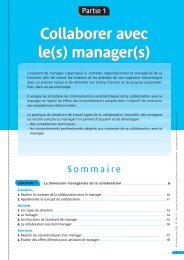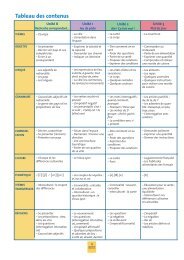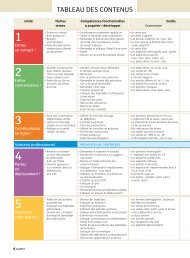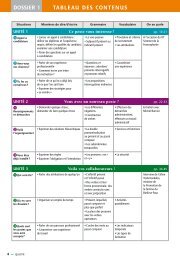GUIDE PÉDAGOGIQUE - Hachette
GUIDE PÉDAGOGIQUE - Hachette
GUIDE PÉDAGOGIQUE - Hachette
Create successful ePaper yourself
Turn your PDF publications into a flip-book with our unique Google optimized e-Paper software.
Le questionnaire que les étudiants seront amenés à<br />
concevoir pourra tenir compte de ces éléments.<br />
2. Les valeurs données dans le document Morale not<br />
money pourront également être réutilisées lors de la<br />
conception du questionnaire.<br />
22 Unit 3 – Human Resources<br />
Morale and money<br />
Script de l’enregistrement<br />
– Have you heard about this business consultant<br />
who gives tips on motivating staff?<br />
– No, tell me about it.<br />
– He advocates a communicative and a humane<br />
approach. His idea is that communication is the clue.<br />
He says one has to listen to workers. The recognition<br />
of workers as individuals is what matters. And if<br />
possible one should try to involve workers in the<br />
running of the firm<br />
– I’m sure this time he’s exaggerating!<br />
– No, believe me, staff should be given access to<br />
training, and when it comes to motivating workers<br />
it’s job satisfaction that counts, not money!<br />
See, what matters for workers is that their<br />
achievement is recognized and praised. What they<br />
want to know as well is how they are going to<br />
be promoted. That’s why the Human Resources<br />
Manager’s got to talk to them and assess them as<br />
often as possible. See, they need to feel that they are<br />
part of a winning team.<br />
He is convinced, and I believe he’s right, that the key<br />
to success is to make sure the goals and ambitions of<br />
the company match those of the employees.<br />
– I wonder if what you both say is realistic, but I<br />
quite like what I’ve heard so far! His philosophy is<br />
that “unity brings strength!” and I go along with<br />
that.<br />
Document 3. matching people<br />
to jobs<br />
a. Le site Monster peut aider l’employeur à sélectionner<br />
des candidats afin d’obtenir la meilleure adéquation<br />
possible entre le poste et le postulant.<br />
Take control of your candidate search<br />
Monster’s Resumé Search gives you the power to<br />
proactively select the most qualified candidates for<br />
your jobs. No more waiting for the perfect person<br />
to apply. No more reviewing countless unqualified<br />
resumés. Instead, you’ll have instant one-click access<br />
to candidates who meet the exact requirements of<br />
your jobs.<br />
Managing resumes When you conduct a search,<br />
you’ll see a list of qualified resumés, including top<br />
level information like the job seeker’s most recent<br />
job title, employer, and desired “target job.” You can<br />
choose a brief or detailed view and sort your results<br />
by resume title, location and posting date.<br />
Rating and sorting candidates Once you’ve saved<br />
favourite resumés, you can use Monster’s resumé<br />
rating tool to easily rank candidates based on how<br />
qualified they are for a given job.<br />
b. Les documents suivants permettent d’apporter des<br />
éléments supplémentaires sur la façon de garder son<br />
personnel.<br />
Matching people to jobs also means an analysis<br />
of the major job requirements (identified in the<br />
job description and performance plan) and related<br />
knowledge, skills, and abilities.<br />
It is the responsibility of supervisors and managers to<br />
utilize available resources to shortlist, train, qualify,<br />
and develop their employees.<br />
An example of employee retention strategy:<br />
1. Assess the organization,<br />
2. Hold people accountable,<br />
3. Measure what is important,<br />
4. Increase employee ownership and involvement,<br />
5. Build relationships and create a positive first<br />
impression,<br />
6. Devise intervention strategies.<br />
http://www.highretention.com/ereport-strategy.html<br />
3. Finding and hiring top talent has never been<br />
tougher than it is today, but retaining star performers<br />
is tougher still. Unfamiliar with the psychology of<br />
work satisfaction, managers reward their best<br />
employees handsomely and assume they’re happy.<br />
But when these employees leave, as they frequently<br />
do, managers conclude that there was nothing they<br />
could have done to prevent the departure. That’s<br />
where they’re wrong. What’s often missing from top<br />
performers’ jobs are responsibilities that coincide with<br />
their “deeply embedded life interests.”<br />
A manager can help uncover an employee’s life<br />
interests by probing, observing, and applying a little<br />
psychology. That done, manager and employee can<br />
customize work with job sculpting – a process that<br />
matches the employee to a job that allows her deeply<br />
embedded life interests to be expressed.<br />
• Ask employees to play an active role in job<br />
sculpting, perhaps by having them write about their<br />
views concerning career satisfaction – an excellent<br />
starting point for a discussion.<br />
• In some cases sculpting can begin simply by<br />
adding a new responsibility. An engineer who has<br />
a deeply embedded life interest in counselling and<br />
mentoring might be asked to plan and manage the<br />
orientation of new hires.<br />
© Éditions Foucher

















